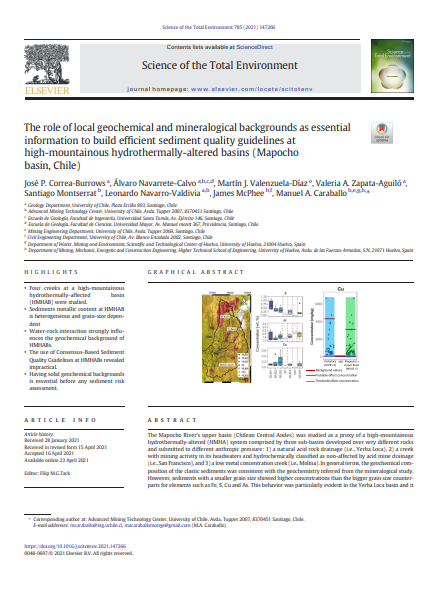The role of local geochemical and mineralogical backgrounds as essential information to build efficient sediment quality guidelines at high-mountainous hydrothermally-altered basins (Mapocho basin, Chile)

Fecha
2021-09-01Autor
Correa-Burrows, José P.
Navarrete-Calvo, Alvaro [Univ Mayor, Fac Ciencias, Escuela Geol, Chile]
Valenzuela-Diaz, Martin J.
Zapata-Aguilo, Valeria A.
Montserrat, Santiago
Navarro-Valdivia, Leonardo
McPhee, James
Caraballo, Manuel A.
Ubicación geográfica
Notas
HERRAMIENTAS
Acceda a títulos restringidos
¿Cómo descargar?Resumen
The Mapocho River's upper basin (Chilean Central Andes) was studied as a proxy of a high-mountainous hydrothermally-altered (HMHA) system comprised by three sub-basins developed over very different rocks and submitted to different anthropic pressure: 1) a natural acid rock drainage (i.e.. Yerba Loca), 2) a creek with mining activity in its headwaters and hydrochemically classified as non-affected by acid mine drainage ( i.e., San Francisco), and 3) a low metal concentration creek (i.e., Molina). In general terms, the geochemical composition of the clastic sediments was consistent with the geochemistry inferred from the mineralogical study. However, sediments with a smaller grain size showed higher concentrations than the bigger grain size counterparts for elements such as Fe, S, Cu and As. This behavior was particularly evident in the Yerba Loca basin and was attributed to the seasonal appearance of Fe- and Al-rich precipitates as constituents of the finer sediments. Different methodologies for the calculation of geochemical backgrounds (Tukey's inner fence, TIF; Median Thledian Absolute Deviation, MAD; and 95th percentile) were tested. Results suggest that the 95th percentile-method was the most appropriate for this type of mountainous systems. Using the selected method-ology, three different geochemical backgrounds were calculated: 1) Yerba Loca basin, 2) Molina basin, and 3) Mapocho Upper basin. When the generated background levels were compared with the Consensus-Based (CB) Sediment Quality Guidelines; Fe, Mn, Zn, Pb, Cu, Cr, Ni and As showed background values that were consistently higher than the values set by the CB Threshold Effect Concentration and, even higher than the CB Probable Effect Concentration for Fe (MUBBBackground: 6.78 wt% vs CB PEC: 4.00 wt%; and Cu (MUBBBackground: 3387 mg kg(-1) vs CB PEC: 149 mg kg(-1)). The present study clearly states the paramount importance of having a solid geochemical background before any attempt of a sediment risk assessment is made at HMHA regions.
URI
https://repositorio.umayor.cl/xmlui/handle/sibum/9153https://doi-org.bibliotecadigital.umayor.cl:2443/10.1016/j.scitotenv.2021.147266
https://doi.org/10.1016/j.scitotenv.2021.147266
Coleccion/es a la/s que pertenece:
Si usted es autor(a) de este documento y NO desea que su publicación tenga acceso público en este repositorio, por favor complete el formulario aquí.